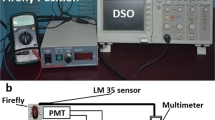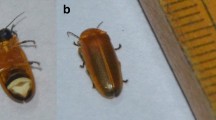Abstract
A low dimensional nonlinear model based on the basic lighting mechanism of a firefly is proposed (Saikia and Bora in Nonlinear model of the firefly flash. http://export.arxiv.org/pdf/2002.01183). The basic assumption is that the firefly lighting cycle can be thought to be a nonlinear oscillator with a robust periodic cycle. We base our hypothesis on the well-known light producing reactions involving enzymes, common to many insect species, including the fireflies. We compare our numerical findings with the available experimental results which correctly predicts the reaction rates of the underlying chemical reactions. Toward the end, a time-delay effect is introduced for possible explanation of appearance of multiple-peak light pulses, especially when the ambient temperature becomes low.







Similar content being viewed by others
References
Agah, A., et al.: A multi-enzyme model for pyrosequencing. Nucleic Acids Res. 32(21), e166 (2004)
Airth, R.L., Foerster, G.E.: The isolation of catalytic components required for cell-free fungal bioluminescence. Arch. Biochem. Biophys. 97(3), 567–573 (1962)
an der Heiden, U.: Delays in physiological systems. J. Math. Biol. 8, 345–364 (1979)
Ando, Y., et al.: Firefly bioluminescence quantum yield and colour change by pH-sensitive green emission. Nat. Photon. 2, 44–47 (2008)
Aprille, J.R., et al.: Role of nitric oxide and mitochondria in control of firefly flash. Integr. Comput. Biol. 44(3), 213–219 (2004)
Bi, W.X., He, J.W., Chen, C.C., Kundrata, R., Li, X.Y.: Sinopyrophorinae, a new subfamily of elateridae (coleoptera, elateroidea) with the first record of a luminous click beetle in asia and evidence for multiple origins of bioluminescence in elateridae. ZooKeys 864, 79–97 (2019)
Branchini, B.R., Magyar, R.A., Murtiashaw, M.H., Portier, N.C.: The role of active site residue arginine 218 in firefly luciferase bioluminescence. Biochemistry 40, 2410–2418 (2001)
Branchini, B.R., Murtiashaw, M.H., Magyar, R.A., Portier, N.C., Ruggiero, M.C., Stroh, J.G.: Yellow-green and red firefly bioluminescence from 5,5-dimethyloxyluciferin. J. Am. Chem. Soc. 124, 2112–2113 (2002)
Branchini, B.R., Southworth, T.L., Khattak, N.F., Michelini, E., Roda, A.: Red- and green-emitting firefly luciferase mutants for bioluminescent reporter applications. Anal. Biochem. 345, 140–148 (2005)
Buck, J., Buck, E.: Synchronous fireflies. Sci. Am. 234(5), 74–85 (1976)
Capinera, J.L.: Encyclopedia of entomology. Springer, Berlin (2008)
Davis, M.P., Sparks, J.S., Smith, W.L.: Repeated and widespread evolution of bioluminescence in marine fishes. PLoS ONE 11(6), e0155154 (2016)
Day, J.C., Tisi, L.C., Bailey, M.J.: Evolution of beetle bioluminescence: the origin of beetle luciferin. Luminescence 19(1), 8–20 (2004)
Ermentrout, B.: An adaptive model for synchrony in the firefly Pteroptyx malaccae. J. Math. Biol. 29, 571–585 (1991)
Fallon, T.R., et al.: Firefly genomes illuminate parallel origins of bioluminescence in beetles. Elife 7, e36495 (2018)
Fan, F., Binkowski, B.F., Butler, B.L., Stecha, P.F., Lewis, M.K., Wood, K.V.: Novel genetically encoded biosensors using firefly luciferase. ACS Chem. Biol. 3(6), 346–351 (2008)
Fraga, H.: Firefly luminescence: a historical perspective and recent developments. Photochem. Photobiol. Sci. 7(2), 146–158 (2008)
Goswami, A., Phukan, P., Barua, A.G.: Manifestation of peaks in a live firefly flash. J. Fluoresc. 29, 505–513 (2019)
Gould, S.J., Subramani, S.: Firefly luciferase as a tool in molecular and cell biology. Anal. Biochem. 175(1), 5–13 (1988)
Guckenheimer, J., Holmes, P.J.: Nonlinear Oscillations, Dynamical Systems, and Bifurcations of Vector Fields. Springer, Berlin (1983)
Hastings, J.W., McElroy, W.D., Coulombre, J.: The effect of oxygen upon the immobilization reaction in firefly luminescence. J. Cell. Physiol. 42(1), 137–150 (1953)
Hirano, T., Hasumi, Y., Ohtsuka, K., Maki, S., Niwa, H., Yamaji, M., Hashizume, D.: Spectroscopic studies of the light-color modulation mechanism of firefly (beetle) bioluminescence. J. Am. Chem. Soc. 131, 2385–2396 (2009)
House, J.E.: Principles of Chemical Kinetics. Academic Press, New York (2007)
Kashova, Z.M., et al.: Mechanism and color modulation of fungal bioluminescence. Sci. Adv. 3, e1602847 (2017)
Kricka, L.J.: Chemiluminescent and bioluminescent techniques. Clin. Chem. 37(9), 1472–1481 (1991)
Lakshmanan, M., Senthilkumar, D.V.: Dynamics of Nonlinear Time-Delay Systems. Springer, Berlin (2011)
McCapra, F.: Chemical mechanisms in bioluminescence. Acc. Chem. Res. 9(6), 201–208 (1976)
McElroy, W.D., Seliger, H.H., White, E.H.: Mechanism of bioluminescence, chemiluminescence and enzyme function in the oxidation of firefly luciferin. Photochem. Photobiol. 10, 153–170 (1969)
Meighen, E.A.: Molecular biology of bacterial bioluminescence. Microbiol. Rev. 55(1), 123–142 (1991)
Mezzanotte, L., van ‘t Root, M., Karatas, H., Goun, E.A., Löwik, C.W.G.M.: In vivo molecular bioluminescence imaging: new tools and applications. Trends Biotechnol. 35(7), 640–652 (2017)
Mirollo, R.E., Strogatz, S.H.: Synchronization of pulse-coupled biological oscillators. SIAM J. Appl. Math. 50(6), 1645–1662 (1990)
Moiseff, A., Copeland, J.: A new type of synchronized flashing in a north american firefly. J. Insect Behav. 13(4), 597–612 (2000)
Okada, K., et al.: Firefly bioluminescence III. Conversion of oxyluciferin to luciferin in firefly. Tetrahedron Lett. 15(32), 2771–2774 (1974)
Oliveira, A.G., Stevani, C.V.: The enzymatic nature of fungal bioluminescence. Photochem. Photobiol. Sci. 8(10), 1416–1421 (2009)
Orosz, G., Moehlis, J., Murray, R.M.: Controlling biological networks by time-delayed signals. Philos. Trans. R. Soc. A 368, 439–454 (2010)
Ow, D.W., et al.: Transient and stable expression of the firefly luciferase gene in plant cells and transgenic plants. Science 234(4778), 856–859 (1986)
Rabha, M.M., et al.: Bioluminescence emissions of female fireflies of the species luciola praeusta. J. Photochem. Photobiol. B 170, 134–139 (2017)
Rand, R.: Complex Systems : Fractionality, Time-Delay and Synchronization, Chapter 3, pp. 83–117. Springer, Berlin (2012)
Roussel, M.R.: Nonlinear Dynamics : A Hands-on Introductory Survey. IOP, Bristol (2019)
Saikia, D., Bora, M.P.: Nonlinear model of the firefly flash. http://export.arxiv.org/pdf/2002.01183
Seliger, H.H., McElroy, W.D.: The colors of firefly bioluminescence: enzyme configuration and species specificity. Proc. Natl. Acad. Sci. USA 52(1), 75–81 (1964)
Sharma, U., et al.: Temperature dependence of the flash duration of the firefly luciola praeusta. Photochem. Photobiol. Sci. 13(12), 1788–1792 (2014)
Shimomura, O., Johnson, F.H., Kohama, Y.: Reactions involved in bioluminescence systems of limpet (Latia neritoides) and luminous bacteria. Proc. Natl. Acad. Sci. USA 69(8), 2086–2089 (1972)
Side, D.D., Nassisi, V., Pennetta, C., Alifano, P., Salvo, M.D., Talà, A., Chechkin, A., Seno, F., Trovato, A.: Bacterial bioluminescence onset and quenching: a dynamical model for a quorum sensing-mediated property. R. Soc. Open Sci. 4, 171586 (2017)
Smith, H.M.: Synchronous flashing of fireflies. Science 82(2120), 151–152 (1935)
Strogatz, S.H.: Nonlinear Dynamics and Chaos: With Applications to Physics, Biology, Chemistry, and Engineering. CRC Press, Boca Raton (2018)
Trimmer, B.A., et al.: Nitric oxide and the control of firefly flashing. Science 292(5526), 2486–2488 (2001)
Tsai, Y.L., et al.: Firefly light flashing: oxygen supply mechanism. Phys. Rev. Lett. 113(25), 258103 (2014)
Tyrrell, A., Auer, G., Bettstetter, C.: Fireflies as role models for synchronization in ad hoc networks (2006)
Wood, K.V.: The chemical mechanism and evolutionary development of beetle bioluminescence. Photochem. Photobiol. 62(4), 662–673 (1995)
Wu, X., Chen, Q., Sun, Y., Fan, X.: Bio-inspired optofluidic lasers with luciferin. Appl. Phys. Lett. 102, 203706 (2013)
Acknowledgements
This work was carried out with a support from the SERB-DST (India) research Grant No. CRG/2018/002971. Necessary computational facilities, in part, are provided through institutional FIST support (DST, India). It is a pleasure to thank Abhijit Sen of IPR (India) for critical comments during the course of this revision.
Author information
Authors and Affiliations
Corresponding author
Ethics declarations
Conflict of interest
The authors declare that they have no conflict of interest.
Additional information
Publisher's Note
Springer Nature remains neutral with regard to jurisdictional claims in published maps and institutional affiliations.
Appendix
Appendix
1.1 Approximation of a DDE system
As we know that a dynamical system with time delay is basically an infinite dimensional system, the delay system can be reduced to a set of N ordinary differential equations, where N is a large positive integer [26].
Consider our DDE with two delays \(\tau _{1,2}\),
assuming \(\tau _{1}>\tau _{2}\) numerically. We now divide the larger of the delay into N different discrete divisions, each of size \({\varDelta }t\) such that \({\varDelta }t=\tau _{1}/N\) or equivalently \(N=\tau _{1}/{\varDelta }t\). As \(N\gg 1\), \({\varDelta }t\) is very small so that we have,
where \(M\,(<N)\) is an integer such that \(M=\tau _{2}/{\varDelta }t\) (please see explanation about M at the end of this section). Denoting now the values of x(t) at a discrete time \(t_{j}\) as \(x_{j}(t)\), we have,
which can be written as
so that we can have now
Following this prescription, we can now write the original DDE system as,
for \(N\gg 1\), which can now be solved with any standard method. For \(N\rightarrow \infty \), the above system will reduce to the original DDEs.
One important point to be noted here about the value of N. While any large positive integer as a value of N will do for a single delay DDE system, for a system with double delays such as in our case, it is important that the difference between the two delays \((\tau _{1}-\tau _{2})\), assuming \(\tau _{1}>\tau _{2}\), is exactly divisible by \({\varDelta }\text {t}\) for the chosen value of N. This is required as we have now divided the entire time interval \([0,\tau _{1}]\) into discrete divisions, the smaller of the delays, which in this case is \(\tau _{2}\) falls exactly at one node, otherwise the discrete set of equations will not maintain the analytical difference between the delays for small values of N. In our chosen set of values of \(\tau _{1}=2.53\) and \(\tau _{2}=2.3\), N should be a multiple of 11. If the difference between the delays is not exactly divisible by \({\varDelta }t\), N should be large enough to make the this difference equivalent to the analytical value, otherwise even a small value of N gives quite good results.
Rights and permissions
About this article
Cite this article
Saikia, D., Bora, M.P. Nonlinear model of the firefly flash. Nonlinear Dyn 101, 1301–1315 (2020). https://doi.org/10.1007/s11071-020-05830-0
Received:
Accepted:
Published:
Issue Date:
DOI: https://doi.org/10.1007/s11071-020-05830-0




